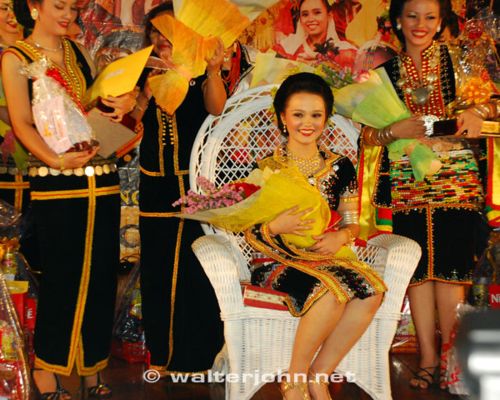Source: http://picasaweb.google.com/
"Unduk Ngadau" owes its origin from that part of Kadazandusun genesis story, which pertains to sacrifice of "Huminodun" – Kinoingan’s only begotten daughter. The legend went on to relate the following:
A long, long time age, the staple food of Kinoingan and his people was a type of grrain called "Huvong". One day, there was no huvong left to plant, nor other grains left for food. Kinoingan was so worried and felt very sorry for his people sufferings. It was said that Kinoingan sacrificed Huminodun, the only child to Kinoingan and Suminundu. She was the most beautiful maiden in her time, truly anyone who gaze at her lovely countenance would be transfixed and fall in love with her. She was also kind hearted and blessed with wisdom beyond her years.
Huminodun was willing to be a sacrifice and be an offering to the great earth so that there will be seeds once agaon for planting and there will be food for the people. Kinoingan was deeply saddened, but seeing that there was nothing else he could do to dissuade her, Kinoingan went ahead and cleared the land for planting. Through his supernatural powers, he was able to clear such a large area over many hills without any difficulty. When the time came for planting, Huminodun was brought to the cleared plot. As she was leaving, one cold hear the pitiful wails of great sadness from Suminundu, her mother. It was not at all easy for Huminodun to leave her mother and likewise her mother letting her only child go. The young men who had fallen in love with Huminodun could not let her go either. Indeed, they too cried and begged her to change her mid. However, there was nothing anyone could do, Huminodun had decided that her father’s people came before her.
When she arrived at the cleared plot, she turned to her father and said: "Father, you will see that my body will give rise to all sorts of edible plants for the people. My flesh will give rise to rice; my head, the coconut; my bones, tapioca; my toes, ginger; my teeth, maize; my knees, yams and others parts of my body to a variety of edible plants. This way never again will our people grow hungry to the point of dying."
"However," Huminodun continued, "Do follow these instructions of mine for it will guarantee us a bountiful harvest. When you have strewn parts of my body all over this clearings, do not come and see me for seven days and seven nights. When the padi has ripened, and it is time for harvest, do not start the harvest without doing this; take seven stalks of rice (padi) and tie them to one end of a spliced bamboo stick and them, plant this stick at the centre of the rice (padi) field. Only after this may you begin your harvesting activities. Later, place this bamboo stick with the seven rice (padi) stalks in the rice (padi) storage container (tangkob) when you bring it home after the harvest. For your first day harvest, do keep them in a big jar (kakanan). And, Father, do not give away your first year’s harvest because the grains may become bad. You can only give away your harvest to others in the second year." (That is why to this day, the Kadazandusun people do not give away their first years harvest.)
Kinoingan agreed to follow all her instructions. So it was that when Kinoingan sacrificed Huminodun, the whole world turned dark and there was awesome thunder and lightning.
That year, the people had never seen such a harvest. It was plentiful. Kinoingan had done as Huminudun instructed He also kept away the first day’s harvest in the kakanan and harvested the first seven stalks of rice from the rice plot. The seven stalks of rice represented Bambaazon, the spirit of the padi or rice.
That year, the people had never seen such a harvest. It was plentiful. Kinoingan had done as Huminudun instructed He also kept away the first day’s harvest in the kakanan and harvested the first seven stalks of rice from the rice plot. The seven stalks of rice represented Bambaazon, the spirit of the padi or rice.
As for the rice in the jar, the kakanan, on the seventh day a beautiful maiden miraculously stood up out of the big jar. She was referred to as Undul Ngadau, the spirit of Huminodun. It was said that this Unduk Ngadau was the one who instructed the first Bobohizan or Kadazandusun priestess in her prayers.
Therefore to this day, the Kadazandusun people have included the Unduk Ngadau Pageant as a grand part of their Kaamatan Festivals. It is a manifestation to the deep sense of respect and admiration that the Kadazandusun people have for the legendary Huminodun. It is a sacred title ascribed to Huminodun, to her absolute abedience to Kinoingam, so much so as to be a willing sacrifice for the sake of the father’s creation. "Unduk Ngadau" then is commemorative term in praise of Huminodun’s eternal youth and the total beauty of her heart, mind and body.
The term "Unduk " or "Tunduk" literally menas the shoot of a plant, which, in it most tangible description, signifies youth and progressiveness. Likewise, in its literal meaning, "Ngadau" or "Tadau" means the sun, which connotes the total beauty of the heart, mind and body of an ideal Kadazandusun woman. In essence therefore the "Unduk Ngadau" is a processual event of selecting from among the Kadazandusun beauties, one who would resemble the ascribed personality of "Huminodun".
Source: http://www.e-borneo.com/ (Experience Borneo Electronically)










